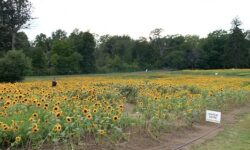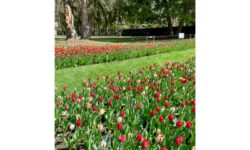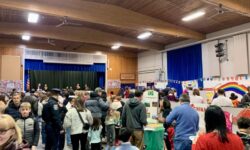By Lenny Strauss
Hometown Weekly Reporter
At the 139th New England Flower show at Elm Bank in Wellesley, gardeners and aficionados from across the states entered their plants, veggies, and assorted flora in a competition that made up part of the annual event sponsored by the Massachusetts Horticultural Society. At this year’s showing, two students, Joey (age 9) and Louise (age 6) Waterman, from Pine Hill Elementary School in Wellesley won the coveted first prizes for their submissions. Their involvement in horticulture is deeply rooted in their family heritage. Their great-great grandfather was Louis Otto Kunkel, National Academy of Science endowed botanist who led the Division of Plant Pathology at the Rockefeller Institute and whose research has formed the groundwork for virulent disease research in potatoes, cabbage and other farming crops. His son, Henry, and grandson Louis, have also served as distinguished scientists within the National Academy of Sciences. Joey and Louise’s grandmother, Carrie Waterman, served on National Committees of the Garden Club of America (GCA), and her 23-year service within the committee has established her as a visionary within the world of horticulture. It is clear that their familial legacy of inspired research work both in horticulture, and science as a whole is well kept as it blossoms through their most recent achievements. We at the Hometown Weekly got to hear from Joey and Louise, along with their mother Sarah, who guided them and helped cultivate their passion and love of plants!
LS: “Tell me more about the Mass Hort flower show? Did you enjoy your experiences?”
JW: “It was good! It was my first year doing it, and I won a pretty big award.”
LS: “Can you tell me about the plants that won first prize?”
SW: “So, for Louise, she entered a Plectranthus plant, its propagated from what’s called a cutting, grown in a little pot. Then she took care of it, rotated and watered it. She won first place in her category for that plant!” (Cutting propagation essentially takes a piece of an established plant that is then used to grow a new, independent plant.)
SW: “[On top of that], this last season Louise collected a bunch of seeds from some columbine plants her grandmother grows in her backyard, planted them in a pot, and took care of them, watered and rotated them as well! Apparently red columbines are very hard to grow from seed, which we didn’t know, and when she entered it, she won the first-place award, the Beket Lang Award, presented to a Junior Horticulturalist, for Louise’s outstanding efforts in growing red columbine from seed.”
JW: “I entered three plants, all in one container garden; a cuphea firecracker, a lantana royale red, and a plectranthus guacamole. I won the President’s junior horticultural award, which is awarded to excellence in junior horticulture, emphasizing the appreciation of unusual or uncommon plant material.”
LS: “Do you have a favorite plant or flower?”
SW: “Louise's favorite flower is one of those little round dahlia flowers!”
JW: “My favorite one that I grew was the cuphea firecracker, but my favorite plant is an Iris.”
LS: “It was very interesting to read about your heritage and the work that your family has done going back so many years. Do your family’s achievements and the work they have done in this field inspire your commitment to being a part of it as well? Do you want to continue your family legacy?”
JW: “I do this for both of the things you described. It’s interesting to learn how plants grow, and how a super tiny seed, like an acorn for example, can grow into a giant oak tree. My great-grandfather, grandfather, and grandmother all like plants, so I feel like I also get my interest in plants from my family.”
LS: “What makes horticulture and garden cultivation such a unique science compared to other realms of agriculture?”
SW: “I think what draws me toward this type of art and science is that it is so accessible to so many people. Anyone can consider themselves a scientist when you plant a garden, and I think that's what can inspire young people to go out there and look at not only the science in understanding the development of the life cycle of the plant, but also that you can say, look at this beautiful garden that's bringing the pollinators to our yard.”
SW: “It really talks about the full cycle of how gardens and native gardens can impact our environment, but I also think it's really exciting to see that anybody can do it. Her grandmother at the flower show said, if a six-year-old can grow red columbine from seed, anybody can do it. It may seem really hard, and we were told that those plants are really finicky, but it worked! It can happen, and you might lose some plants along the way, and may need to compost some, but in the long run we are showing that we can grow art as well.”
SW: “We can grow a beautiful garden, but also teach the next generation how that garden grows and we know what that impact is going to be on our mother earth and how it's going to not only just make it a more beautiful place, but really how it's going to actually impact every living thing that interacts with that plant, from the insects to the dirt. I think for me, it just makes it that everybody can be a scientist when they garden.”
The next New England Fall Flower Shower will be back September 18-20, 2026.






















